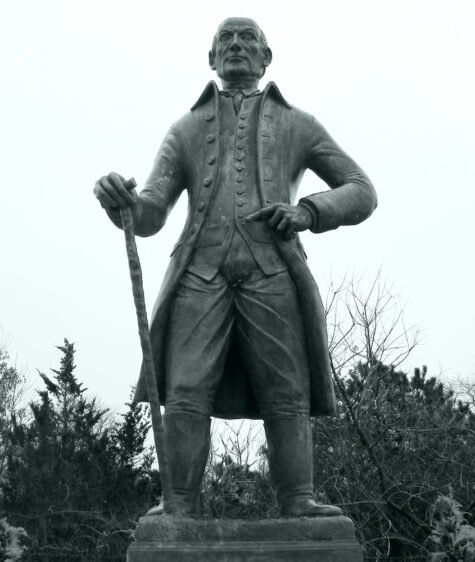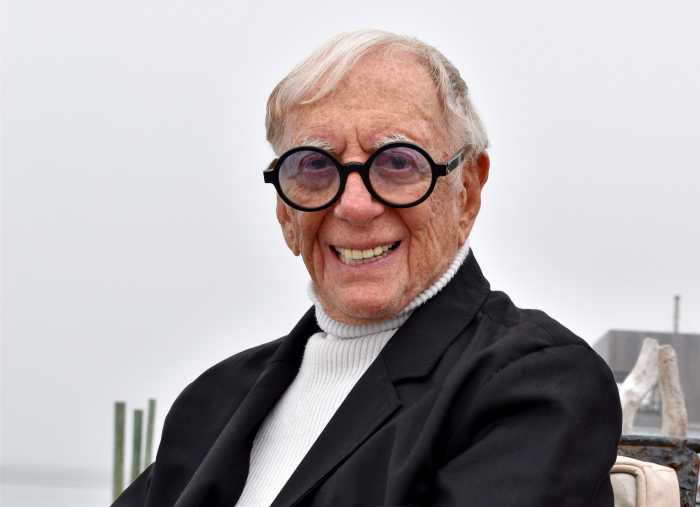
LIKE ROBERT MOSES, an additional sea of online petitions and protests have crashed on the shores of Long Island, surrounding what many residents believe to be another heavily celebrated figure worth discussing – William Floyd.The sole Suffolk County signer of the Declaration of Independence is currently being scrutinized online through a harsher lens.
A petition presented to the Town of Brookhaven on June 5 advocates to “remove, relocate, contextualize, or cover” the monument of William Floyd because the statue stands for “subliminal, institutionalized racism.” This petition now has close to 3,500 signatures.Other tributes to Floyd include his namesake town in Upstate New York; William Floyd Parkway; William Floyd School District; and the William Floyd Estate in Mastic Beach, which is under jurisdiction of Fire Island National Seashore.“This statue is in the center of our community,” says Desiree Magee, a 27-year-old Shirley resident who started the petition.
“It was only brought here a few years ago and I feel that in a community of color, as close to a Native American reservation as we are, we should not celebrate a man like William Floyd.”Born in 1734, Floyd was the first delegate from New York that signed the Declaration of Independence, according to the William Floyd School District website. Long Island Press further adds that the Floyd family is written into history as one of the first families to embrace the practice of slavery in the Town of Brookhaven.
In the Federal Census of 1790, records indicate that the Floyd household enslaved 14 people and five free people of color.An article written by the Fire Island News in 2019, divulges the history of the William Floyd estate, establishing that William’s grandfather, Richard Floyd, purchased the 4,400 acres of Mastic Beach from the Smith’s of the Manor of St. George in 1718. One of four siblings, William inherited the estate at the age of 20, subsequent to his father Nicoll’s early death.Only two miles from the William Floyd Estate lies one of the two Native American reservations in Suffolk County, the Poospatuck Reservation, home to the Unkechaug tribe.It is noted in an ethnographic overview and assessment of the Fire Island Seashore that many Native Americans were subjected to indentured servitude for the Floyd family. According to information published by Columbia University, Unkechaug peoples married free and enslaved African Americans, and their descendants remain in the area.
Prior to the abolishment of slavery in 1827, the plantation’s vast crop and livestock holdings were maintained by the labor of slaves, indentured servants and free laborers dating back to William’s grandfather. There is not much historical information to describe the relationship between the Floyd’s and these workers, but doctor and shoemaker’s bills suggest that the family cared for them, according to the Fire Island News article.This same article continues to elaborate on the family who called the estate home for more than 250 years, eventually annexed to the Fire Island National Seashore by an act of Congress in 1965. It mentions that the family grew more affluent from the farm’s success, demonstrated by receipts from New York stores as the years passed.
Also written into history, William’s sisters, Ruth and Charity, married Generals Nathaniel Woodhull and Ezra L’Hommedieu. Through these extended family relations, Floyd had ties to the both the Culper Spy Ring and the largest slave plantation north of the Mason Dixie Line, the Sylvester Manor on Shelter Island, according to the Long Island Press.Before the American Revolution, Floyd served as a Town of Brookhaven trustee and colonel in the Suffolk militia. He was then chosen to represent New York in the First Continental Congress of 1774, and would remain speaking on behalf of the state until 1776. The comfort of the estate would evade the Floyd’s for several years, after his signing of the Declaration of Independence labeled him a traitor to King George of England.
In August of 1776, New York was lost in battle to British control and would remain under their reign until the conclusion of the Revolutionary War. William and his family fled to Connecticut where he continued to serve the nation in Congress. Following the Treaty of Paris, the Floyd’s returned to his estate, which was ravaged but still standing.
After the Revolutionary War, the National Parks Service states that Floyd continued to tinker in politics while managing his plantation. He served as a state senator and two-time presidential elector until his passing at the age of 86 in 1821, when the Old Mastic House was passed down to his son. Following his death, generations of decedents managed the estate that evolved from slave ownership to active military service in the Union army during the American Civil War, according to the New York Almanac.
Today direct scions of William Floyd include singer/ songwriter David Crosby; and former Massachusetts Governor Bill Weld, who recently made a unsuccessful bid for U.S. President.
The vast estate once visited by Thomas Jefferson, James Madison and Marquis de Lafayette has a wooden path that leads to the Floyd family cemetery. The adjacent slave plot is only a few feet away. In contrast to some very ornate headstones, the simple white cross markers state the first names of these individuals where they rest. Curiously, William is one of the few Floyd’s not buried in the family cemetery; he is buried in upstate New York where he spent the last decades of his life.
On Long Island, his memory stands tall with a 7-foot bronze statute, situated at the top of the county-owned intersection of William Floyd Parkway and Montauk Highway. Italian-born Artist Santo Matarazzo donated the statue in 2004. It stood at the Mastic-Moriches-Shirley Community Library for a few years until Suffolk County moved the statue to its current location in 2013.
Beth Wahl, president of the William Floyd Community Summit, was unable to be sought for comment for this article. She said in an interview with Patch that the grassroots organization’s beautification committee was once chaired by Pat Matthews, a woman who dreamed of having a statue of William Floyd erected to commemorate Suffolk County’s founding father.
“Our schools…our highways… an estate…a mu- seum…are all already named after this man,” Magee said. “I do think there is a better place for it than in the center of our community.”A subsequent petition was created in response to Magee’s, advocating that the statue should stay in place. The petition creator, Vincent Viola, could not be reached for comment. He represents a group of proponents that Floyd is “not a symbol of racism” and claims rather that he “represented the people of Long Island and New York at a time when the people had to step up and change the systemic way they were governed.” The petition has close to 4,000 signatures.
Meanwhile, on the eve of Bastille Day, the board of Floyd Memorial Library in Greenport entered into discussions as whether to have a portrait of William Floyd that hangs above the circulation desk removed. The library, chartered in 1907, was not named after William Floyd, but one of his grandchildren, David Gelston Floyd.




























